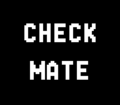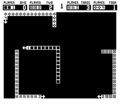
| Checkmate | |
|---|---|
| Developer(s) | Midway Games |
| Publisher(s) | Midway Games |
| Year released | 1977 |
| System(s) | Arcade, Bally Astrocade |
| Genre(s) | Action |
|---|---|
| Players | 1-4 |
| Modes | Single player, Multiplayer |
- This guide is for the 1977 Midway arcade game. For the 1999 Altron Corp. Game Boy Color game, see Checkmate (1999).
Checkmate is an arcade game, that was released by Midway Games in 1977; it utilizes an Intel 8080 microprocessor (running at 1.9968 MHz), and was the first game from the company that allowed up to four players to play simultaneously. All four players must use a 4-way joystick and take up control of a snake-like line which leaves a trail behind it (if there are less than four players, the remaining lines will be controlled by the CPU) - and the objective is to force all other lines, regardless of whether they are player- or CPU-controlled, into the walls or your own trails (much like in Gremlin Industries' Blockade, Comotion and Hustle). Every time one line gets forced into a wall or another line, the text "PLAYER X CHECKS OUT/MEETS HIS MAKER/PRONOUNCED DEAD" (X being 1, 2, 3, or 4), will appear at the bottom of the screen; once there is only one line left, it's declared the winner of the current round and will receive a single point. Depending on how the cabinet is set, a game can be between two and five rounds long - and, whichever line has the most points at the finish will get declared the overall winner (which means that if any of the CPU-controlled lines have more points than yours at the end they will be considered the overall winners). Atari's Dominos (which was also released in 1977), also features similar gameplay to this title; however, it will only allow up to two players to play it as opposed to four.
-
Title screen.
-
Upright arcade cabinet.
-
Screenshot of the game.



